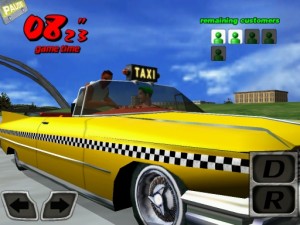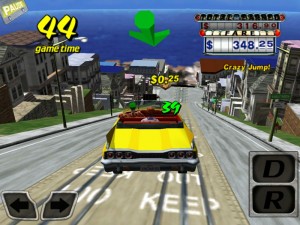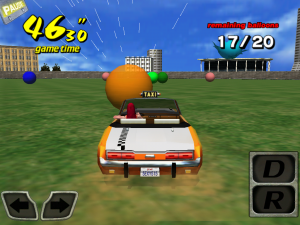Would you like to hop into a classic sports car, barrel down the road at reckless speeds, all while trying to quickly deliver as many daredevil passengers to their destinations as possible before time runs out? If you answered yes to all of these questions then you will definitely want to check out Sega’s recent iOS release of Crazy Taxi (out now, $4.99), a polygon perfect port of the Dreamcast edition of the arcade classic. I’ll be honest and admit that I myself wouldn’t have believed such a thing was possible if I hadn’t seen it with my own two eyes, but the package does contain both towns – as well as the plethora of training challenges – in all their resplendent glory.
 The premise of Crazy Taxi – for those of you who haven’t played the original classic before (shame on you) – is that you need to pick up and deliver passengers before time runs out, with successful early deliveries adding time back to the clock. It should be noted that your passengers are about as reckless as you are and will pay more if you thrill them along the way with death-defying stunts, especially if you can perform them in long uninterrupted streaks. I should probably remind you all right now that Crazy Taxi was originally designed to be a brutal quarter muncher, therefore – while the above sounds easy enough on paper – much practice will be needed before you have a run valuable enough to earn the coveted S-Class license.
The premise of Crazy Taxi – for those of you who haven’t played the original classic before (shame on you) – is that you need to pick up and deliver passengers before time runs out, with successful early deliveries adding time back to the clock. It should be noted that your passengers are about as reckless as you are and will pay more if you thrill them along the way with death-defying stunts, especially if you can perform them in long uninterrupted streaks. I should probably remind you all right now that Crazy Taxi was originally designed to be a brutal quarter muncher, therefore – while the above sounds easy enough on paper – much practice will be needed before you have a run valuable enough to earn the coveted S-Class license.
The iOS port of Crazy Taxi features two control schemes: one entirely based around on screen buttons, and the other one utilizing the tilt sensors inside your device for steering purposes. I’m going to say this right away and flat out advise everyone to immediately opt for the tilt based controls as Crazy Taxi is a game that demands a degree of precision in your steering, and you simply aren’t going to get it from the non-analog left and right buttons. Whichever method you do choose to control your hurtling yellow death-machine/taxi-cab, there will always be forward and reverse buttons presents on the right hand side of the game’s screen.
 One thankful addition to Crazy Taxi for the iOS, which was never seen in other releases of the game when using a steering wheel device instead of a controller, is the merciful inclusion of a drift button. It used to be that the method for initiating power drifts, which are absolutely vital to scoring massive amounts of ‘crazy money’, was the exact same whether you were playing the game with an analog control stick or a more arcade accurate steering wheel. This lead to a comical disparity where it was actually far easier to earn ‘crazy money’ when not using an arcade accurate steering wheel, since the methods for initiating a power drift were ridiculously hard to pull off on a wheel versus an analog stick. The iOS port manages to avoid this unfairness by simply having a button that automatically initiates drifts whenever you are using the more steering wheel esque tilt based control system.
One thankful addition to Crazy Taxi for the iOS, which was never seen in other releases of the game when using a steering wheel device instead of a controller, is the merciful inclusion of a drift button. It used to be that the method for initiating power drifts, which are absolutely vital to scoring massive amounts of ‘crazy money’, was the exact same whether you were playing the game with an analog control stick or a more arcade accurate steering wheel. This lead to a comical disparity where it was actually far easier to earn ‘crazy money’ when not using an arcade accurate steering wheel, since the methods for initiating a power drift were ridiculously hard to pull off on a wheel versus an analog stick. The iOS port manages to avoid this unfairness by simply having a button that automatically initiates drifts whenever you are using the more steering wheel esque tilt based control system.
Sometimes games – in order to save money – will remove all examples of licensed music when they get rereleased years later, but I am happy to report that purists will be happy to hear that all of the songs by Offspring and Bad Religion are still present in the iOS port of Crazy Taxi. What’s even better is that the iOS port of Crazy Taxi takes things a step further and gives players the chance to experience their madcap taxi driving adventures while listening to any of the songs already present on their iOS device. The feature is far from perfect since players must checkmark which songs they want to use one at a time (there is no select all option) and the list will have to be completely rebuilt from scratch should a player ever want to revert back to the game’s original music. All the same, even with shortcomings regarding ease of use taken into consideration, it’s still a great feature that is far too seldomly seen in games built for a device whose primary function was supposed to be music playback.
 The only part of this impressive package that might sour the experience for fans who invested heavy amounts of time into Crazy Taxi back on the Dreamcast is this: the difficulty of relearning how to play. While the tilt based controls are a 100% capable method of operating the game, it will not be an intuitive leap for a player traditionally used to earning ‘crazy money’ with an analog stick. However, if the gamer gets past their initial shock – which will probably be a lot like an unceremonious toss into a freezing body of water – they will quickly learn that this is one case where control differences in an iOS port doesn’t automatically mean inherently inferior. Thankfully, the game’s training challenges – ported faithfully from the original home release – can be heavily instrumental in helping both old and new players alike in learning how to successfully play Crazy Taxi on their iOS device.
The only part of this impressive package that might sour the experience for fans who invested heavy amounts of time into Crazy Taxi back on the Dreamcast is this: the difficulty of relearning how to play. While the tilt based controls are a 100% capable method of operating the game, it will not be an intuitive leap for a player traditionally used to earning ‘crazy money’ with an analog stick. However, if the gamer gets past their initial shock – which will probably be a lot like an unceremonious toss into a freezing body of water – they will quickly learn that this is one case where control differences in an iOS port doesn’t automatically mean inherently inferior. Thankfully, the game’s training challenges – ported faithfully from the original home release – can be heavily instrumental in helping both old and new players alike in learning how to successfully play Crazy Taxi on their iOS device.
Speaking of things in Crazy Taxi that can help people learn how to drive their cab like an insane pro, as well as better learn the layout of the game’s digital cities, is the inclusion of the Dreamcast edition’s ‘Drive for X Minutes’ mode. Where as normally the player must doggedly pick up and deliver passengers in order to keep the clock ticking, this mode challenges the gamer to see how many passengers they can deliver in an immutably fixed volume of time. Naturally – to keep everything fair – Crazy Taxi has separate leader boards based on not only which virtual city the player collects their ‘crazy money’ in, but also on the basis of whether not the far more brutal arcade style rules were in effect.
iFanzine Verdict: Crazy Taxi for iOS is a polygon perfect port of Sega’s reckless driving classic from the arcade and Dreamcast, specifically including all of the additions from the home console release. Not only does the iOS edition include all of the same licensed music by Offspring and Bad Religion that were originally seen in Crazy Taxi over a decade ago, but the game also lets the player earn ‘crazy money’ while listening to any of the songs already uploaded to their iOS device as well. The only downside to this package is that long time fans of the series will experience some controller shock in the process of adjusting to the port’s tilt based steering method, but the new control scheme is more than up to the task once the player finishes reacclimating.

